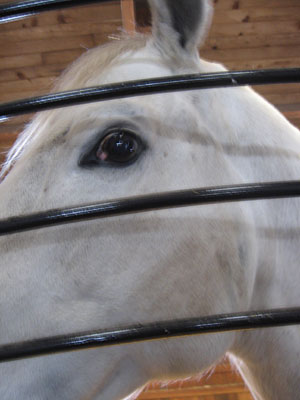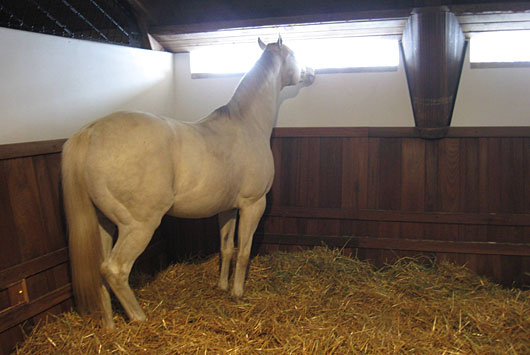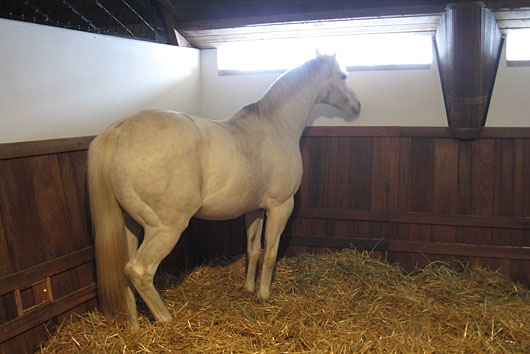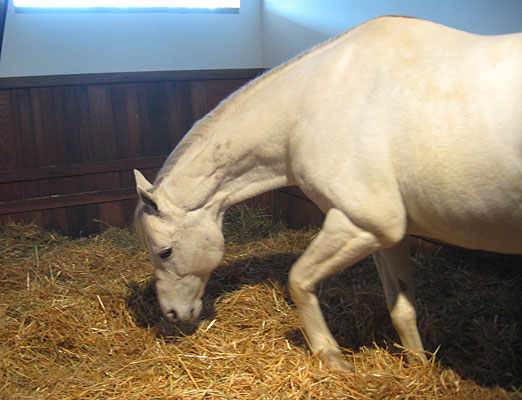It seems as if the name Tapit is everywhere these days, especially on the Derby trail, where promising 3-year-olds such as Coup de Grace, Constitution, Giancarlo, Hartford, Harpoon, Matterhorn, Tap it Rich. Tapiture, Tonalist and others have already graced the winner’s circle, the majority of them in 2014.
There is no doubt that Tapit is one of the hottest stallions in America, but few remember the horse when he was on the Derby trail himself, and a close third choice in the 2004 Run for the Roses following his victory in the Wood Memorial.
Although Tapit won the Wood in a tight three-horse finish, his victory told a great deal about the horse and perhaps why he has been so successful as a sire.
One of the everlasting images of that year’s Derby was Tapit’s arrival at Churchill Downs with trainer Michael Dickinson. It was a sight no one had ever seen before and won’t see again in the foreseeable future.
As everyone is well aware, there is nothing conventional about Dickinson, who has always marched to the beat of his own drum.
When Dickinson shipped Tapit to Churchill Downs on the Wednesday before the Kentucky Derby, the conditioner brought a little bit of his farm with him.
"The Mad Genius", as Dickinson is often called, packed the colt's daily treats of Guinness beer and three eggs, along with a long swath of sod and grass from his Tapeta Farm in Maryland for his daily grazing sessions to make the transition from Tapeta to Churchill a littler easier for the son of Pulpit. It was an odd sight watching Dickinson lay his carpet of grass out over the grass outside the receiving barn.
"I want to make my horse as comfortable as possible," Dickinson said. "He gets his one beer and three eggs every day at the farm mixed with his grain. He likes the grass the best. It's part of his natural diet."
Dickinson said he prefers training at his North East, Md., farm as opposed to at a racetrack. "It's tough training at the track and it's very hard for one guy to rise above the rest. If I were at the track I would probably starve," he said.
"At the farm I am free to improvise. I can breeze my horses at 3 p.m. if I so choose. I don't but I could.
He also brought with him several other conveniences, such as a heat lamp, camera etc, which he promptly install in Tapit’s stall.
Pulling off remarkable training feats at Tapeta was nothing out of the ordinary for Dickinson. Certainly everyone remembered Da Hoss. After winning the 1996 Breeders' Cup Mile, Da Hoss was sidelined for nearly two years with a bowed tendon and other maladies. Dickinson nursed him back to health to win the 1998 Breeders' Cup Mile after just one minor prep race at Colonial Downs.
Tapit went into the Derby off only four career starts, and in one of them, the Florida Derby, he was sick and ran poorly.
"My health always reflects my horses health," Dickinson said. "He was sick so I was sick. We're both feeling a lot better now."
Tapit gave Dickinson a pleasant and emotional surprise by winning the Wood Memorial, a race Dickinson was convinced the colt was going to lose, due to all the time and training he missed being sick. But it became apparent that this was no ordinary horse.
Dickinson stood off in a corner of the Aqueduct winner’s circle and tried his best to explain how Tapit managed to win the Wood. But even he couldn’t do it. This was more than just another logic-defying conquest by “The Mad Genius.” Although some perceive Dickinson to be a graduate of the Hogwarts School, performing Harry Potter-like feats of magic, he knew there was nothing wizardly about this latest feat.
This was simply a trainer in awe of a horse. Tapit had overcome one setback after another that winter and spring, and somehow was still in the Kentucky Derby picture, despite missing 19 days of training with shin problems, and coming out of his sixth-place finish in the Florida Derby with a serious lung infection and a foot abscess.
“He won’t win the Wood,” Dickinson said a week before the race. “He’s not fit enough. I’ll be over the moon if he can finish third.”
Now, here he was trying to explain how Tapit could come from dead-last over a speed-biased track, circle the field five wide, and mow down every one of his 10 opponents to win by a half-length. And this with only one race all year and only one serious work since the Florida Derby.
“I was dreading the race, because I knew he wasn’t fit,” Dickinson said. “He’s a very generous horse, and he has such a big heart.”
By now, the words were becoming difficult to get out. Tears were welling up, and his voice began to quaver noticeably. “I felt I was putting him into battle unprepared,” he continued. “And if anything had happened I would have blamed myself. But the horse carried me through, and I’m indebted to him. He’s such a generous horse and we love him dearly.”
Tapit had earned a lofty reputation among the previous year’s 2-year-olds. After breaking his maiden at Delaware Park by 7 3⁄4 lengths, he then put on a sensational display of class, speed, and courage by winning the Laurel Futurity by 4 3⁄4 lengths with a breathtaking burst of speed, despite a nightmarish trip in which he was bumped early and forced to steady for a good portion of the race.
Now, five months later, he was trying to earn his way into the Kentucky Derby field in a most unconventional manner. But as it turned out, Tapit proved to be as unconventional as his trainer, who has made a habit of doing the impossible.
“When we came home from Florida, we did an ultrasound, and it showed he had a very significant lung infection,” Dickinson said. “We did another ultrasound two weeks later and one lung was 100% and the other was 80%. We gave him a little five-furlong breeze and he could blow a house down. I was going to wheel him back and work him a mile, but I told (owner Ron Winchell and manager David Fiske) I’ve got to give him as long as I dare to get him healthy and give the lungs a chance to heal. It takes 28 days for the lung to get a new lining.”
Dickinson gave Tapit several extra days and worked him a mile in 1:47 over the uphill course at his Tapeta Farm in North East, Md. On the Wednesday before the Wood, another ultrasound found one lung to be 100% and the other 99.9%. Although the colt finally was healthy, he still had only the one serious work and was about two weeks from being 100% fit. But Dickinson had no choice but to send a partially fit Tapit into the Wood, in which he’d face the brilliant Florida Derby runner-up, Value Plus, and Master David and Eddington, who, like Tapit, were in desperate need of graded stakes earnings to assure a place in the Kentucky Derby field.
“We’re just going to be out the back and pass beaten ones at the end,” Dickinson said after analyzing the race and plotting strategy. “We’re never going to be in the race; we’re just going to come late and easy and hope to get third. I’ve already told the owner he’s not fit, but he will be on May 1.”
What Dickinson feared going into the Wood was that Tapit, being such a generous and competitive horse, would try too hard and give more than what was expected of him.
“He never knew he was sick,” Dickinson said. “Even when he’s not well he’s always perky. Nothing gets him down.”
Tapit has a reputation at Tapeta as being unpredictable and always getting into mischief. One day, Dickinson’s partner in life, Joan Wakefield, heard a racket in Tapit’s stall and went running over to see what was happening. The colt had grabbed the rubber mat in his mouth and was flinging it wildly against the wall of his stall.
“He’s just a flamboyant little horse, who’s always full of life,” said exercise rider Jon “John Boy” Ferriday.
Dickinson previously had trained grade I winner Fleet Renee for California owner Verne Winchell. At the 2002 Keeneland September yearling sale, Winchell, his son Ron, and Fiske purchased the son of Pulpit—Tap Your Heels, by Unbridled, for $625,000, which was about $100,000 more than Winchell usually would spend for a young horse. He had been recommended by Dr. David Lambert after Lambert performed a heart scan on the colt. Winchell asked Dickinson what he thought of the horse, who was bred in Kentucky by Oldenburg Farms, and when the trainer said he liked him, Winchell promised him the horse. After being broken in Texas by Keith Asmussen, Tapit was sent to Tapeta Farm in May of 2003.
But Tapit would be the last horse Winchell would purchase. Two months after the sale, Winchell died of a heart attack at age 87. “He was a star, an absolute star,” Dickinson said. “He was a true gentleman and he loved his horses.”
“Obviously, being the last horse we ever bought together carries some sort of emotional impact,” Ron Winchell said.
Dickinson, as usual, vanned Tapit up to Aqueduct the morning of the race, arriving at around 9 a.m. Value Plus was made the 5-2 favorite, with Eddington at 3-1, Master David 7-2, and Tapit getting played, illness or no illness, at 5-1.
At the start of the Wood, Tapit got shuffled back to last, as Lane’s End Stakes winner Sinister G broke like a shot from the nine post and engaged Value Plus to his inside. The pair were joined by longshot Cuba, but managed to get away with an opening quarter in :23.74 over a blazing racetrack. Eddington and Master David were running side by side, with the latter down on the rail. Ramon Dominguez steered Tapit to the outside down the backstretch and let him gradually pick up horses. The pace remained even, with a half in :47.12 and three-quarters in 1:11.40.
Value Plus was still battling with Sinister G when Eddington and Swingforthefences charged up on the outside, with Alex Solis, on Master David, finding an inviting opening along the rail. By now, Tapit was in full gear without Dominguez even having to ask him. He swung him to the far outside, as the favorites charged down the stretch. Sinister G cracked under the pressure, then Value Plus followed, leaving the four horses in need of earnings battling for the all-important top two spots. Swingforthefences couldn’t sustain his move, and then it was down to three.
Master David slipped through to take a narrow lead over Eddington, who, as usual, was having trouble changing leads.
Just when it looked like Master David had the race won, Tapit, his head cocked toward the grandstand, came charging up on the outside like a dead-fit horse and spurted in the final yards to win by a half-length, covering the 1 1⁄8 miles in 1:49.70.
There was a photo for second and third. Eddington had finally changed leads with the help of jockey Jerry Bailey, and he and Master David hit the wire together. One horse would be heading to Kentucky, while the other would have to wait and see how things shaped up over the next three weeks. Soon after, Master David’s number went up. Trainer Bobby Frankel would be returning for another shot at the Derby after coming so close the previous year with Empire Maker.
Ferriday headed back with Tapit, and was amazed what the colt had accomplished. “He’s a brilliant horse to have pulled this off,” he said. To demonstrate how tough a horse Tapit was, he coughed the entire way from the winner's circle to the test barn.
For Dickinson, the worrying was far from over. “Now, the question is, will he bounce? I want to see him scoped, and see how he’s doing tonight and tomorrow,” he said. “We’ll weigh him tonight and every day. The secret of how quickly a horse gets over a race is how quickly they return to their normal weight.”
Dickinson had managed to hold back his tears, and barely was able to get out his words of pride and admiration for Tapit, but when he was asked, “So, what’s up next for this horse?” he couldn’t help but shift gears and break into a little smirk. Trying to keep a straight face, he replied, “Well, there’s a race on the first of May. I’ve forgotten its name.”
Whether Tapit did bounce in the Derby or simply couldn’t get hold of the slick sloppy track, he wound up ninth without ever putting in a run.
Put away and targeted for the Haskell Invitational, he was forced to miss the race due to throat surgery. When he returned in the Pennsylvania Derby and finished ninth again, it was decided, to retire him to Gainesway Farm for a $15,000 stud fee. Although he was perfectly sound, he had had an up and down year, incurring a number of setbacks.
There was no denying the colt’s potential and his natural talent, as well as his ability to bounce back from adversity and do things most horses would find impossible. He had demonstrated a rocket of a move, and the ability to decimate his opponents or mow them down late.
With only six lifetime starts, we’ll never know how good Tapit could have been on the track. But we sure know how good he is in the breeding shed. And now, his offspring are giving us a hint of what we might have witnessed had he continued his racing career.
Tapit at Gainesway Farm - Photos by Steve Haskin









